初中英语一般现在时知识点
- 格式:doc
- 大小:12.26 KB
- 文档页数:3
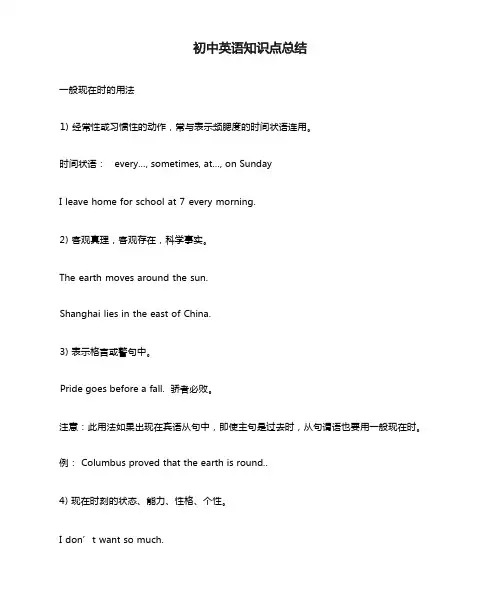
I don ’t want so much.一般现在时的用法1) 经常性或习惯性的动作,常与表示频腮度的时间状语连用。
时间状语: every …, sometimes, at …, on SundayI leave home for school at 7 every morning.2) 客观真理,客观存在,科学事实。
The earth moves around the sun.Shanghai lies in the east of China.3) 表示格言或警句中。
Pride goes before a fall. 骄者必败。
注意:此用法如果出现在宾语从句中,即使主句是过去时,从句谓语也要用一般现在时。
例: Columbus proved that the earth is round..4) 现在时刻的状态、能力、性格、个性。
Ann Wang writes good English but does not speak well.比较: Now I put the sugar in the cup.I am doing my homework now.第一句用一般现在时,用于操作演示或指导说明的示范性动作,表示言行的瞬间动作。
再如:Now watch me, I switch on the current and stand back. 第二句中的 now 是进行时的标志,表示正在进行的动作的客观状况,所以后句用一般现在时。
2. 一般过去时的用法1 )在确定的过去时间里所发生的动作或存在的状态。
时间状语有: yesterday, last week, an hour ago, the other day, in 1982 等。
Where did you go just now?2 )表示在过去一段时间内,经常性或习惯性的动作。
When I was a child, I often played football in the street.Whenever the Browns went during their visit, they were given a warm welcome.3 )句型:It is time for sb. to do sth " 到……时间了" "该……了"It is time sb. did sth. " 时间已迟了" "早该……了"It is time for you to go to bed. 你该睡觉了。
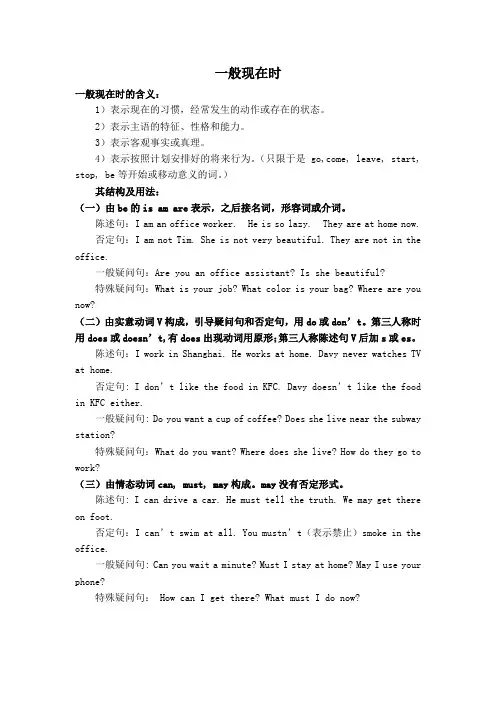
一般现在时一般现在时的含义:1)表示现在的习惯,经常发生的动作或存在的状态。
2)表示主语的特征、性格和能力。
3)表示客观事实或真理。
4)表示按照计划安排好的将来行为。
(只限于是go,come, leave, start, stop, be等开始或移动意义的词。
)其结构及用法:(一)由be的is am are表示,之后接名词,形容词或介词。
陈述句:I am an office worker. He is so lazy. They are at home now.否定句:I am not Tim. She is not very beautiful. They are not in the office.一般疑问句:Are you an office assistant? Is she beautiful?特殊疑问句:What is your job? What color is your bag? Where are you now?(二)由实意动词V构成,引导疑问句和否定句,用do或don’t。
第三人称时用does或doesn’t,有does出现动词用原形;第三人称陈述句V后加s或es。
陈述句:I work in Shanghai. He works at home. Davy never watches TV at home.否定句: I don’t like the food in KFC. Davy doesn’t like the food in KFC either.一般疑问句: Do you want a cup of coffee? Does she live near the subway station?特殊疑问句:What do you want? Where does she live? How do they go to work?(三)由情态动词can, must, may构成。
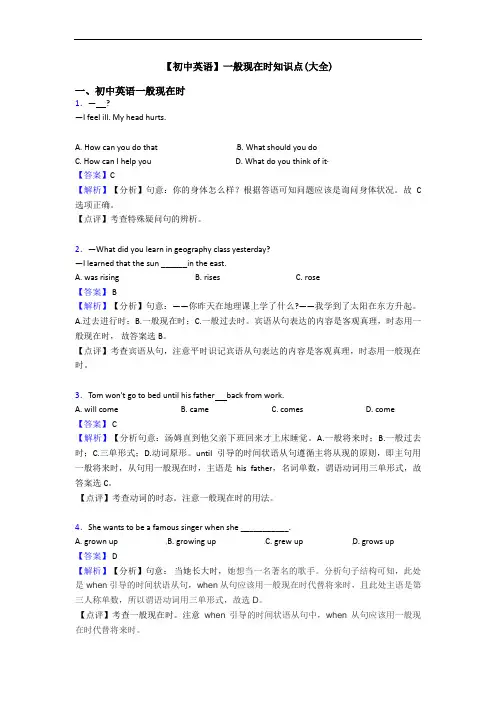
【初中英语】一般现在时知识点(大全)一、初中英语一般现在时1.— ?—I feel ill. My head hurts.A. How can you do thatB. What should you doC. How can I help youD. What do you think of it·【答案】C【解析】【分析】句意:你的身体怎么样?根据答语可知问题应该是询问身体状况。
故C 选项正确。
【点评】考查特殊疑问句的辨析。
2.—What did you learn in geography class yesterday?—I learned that the sun ______in the east.A. was risingB. risesC. rose【答案】 B【解析】【分析】句意:——你昨天在地理课上学了什么?——我学到了太阳在东方升起。
A.过去进行时;B.一般现在时;C.一般过去时。
宾语从句表达的内容是客观真理,时态用一般现在时,故答案选B。
【点评】考查宾语从句,注意平时识记宾语从句表达的内容是客观真理,时态用一般现在时。
3.Tom won't go to bed until his father back from work.A. will comeB. cameC. comesD. come【答案】 C【解析】【分析句意:汤姆直到他父亲下班回来才上床睡觉。
A.一般将来时;B.一般过去时;C.三单形式;D.动词原形。
until引导的时间状语从句遵循主将从现的原则,即主句用一般将来时,从句用一般现在时,主语是his father,名词单数,谓语动词用三单形式,故答案选C。
【点评】考查动词的时态。
注意一般现在时的用法。
4.She wants to be a famous singer when she ___________.A. grown upB. growing upC. grew upD. grows up【答案】 D【解析】【分析】句意:当她长大时,她想当一名著名的歌手。
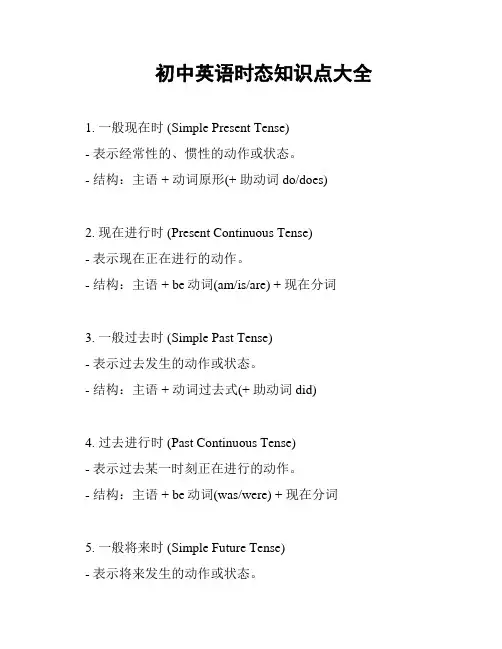
初中英语时态知识点大全1. 一般现在时 (Simple Present Tense)- 表示经常性的、惯性的动作或状态。
- 结构:主语 + 动词原形(+ 助动词do/does)2. 现在进行时 (Present Continuous Tense)- 表示现在正在进行的动作。
- 结构:主语 + be动词(am/is/are) + 现在分词3. 一般过去时 (Simple Past Tense)- 表示过去发生的动作或状态。
- 结构:主语 + 动词过去式(+ 助动词did)4. 过去进行时 (Past Continuous Tense)- 表示过去某一时刻正在进行的动作。
- 结构:主语 + be动词(was/were) + 现在分词5. 一般将来时 (Simple Future Tense)- 表示将来发生的动作或状态。
- 结构:主语 + will + 动词原形6. 现在完成时 (Present Perfect Tense)- 表示过去发生的动作对现在产生的影响。
- 结构:主语 + have/has + 过去分词7. 过去完成时 (Past Perfect Tense)- 表示在过去某一时刻之前已经发生的动作。
- 结构:主语 + had + 过去分词8. 将来进行时 (Future Continuous Tense)- 表示将来某一时刻正在进行的动作。
- 结构:主语 + will + be动词 + 现在分词9. 将来完成时 (Future Perfect Tense)- 表示将来某一时刻之前已经完成的动作。
- 结构:主语 + will + have + 过去分词10. 现在完成进行时 (Present Perfect Continuous Tense)- 表示从过去某时开始持续到现在的动作并可能继续下去。
- 结构:主语 + have/has + been + 现在分词11. 过去完成进行时 (Past Perfect Continuous Tense)- 表示过去某时开始,持续到过去某时并有可能继续下去的动作。
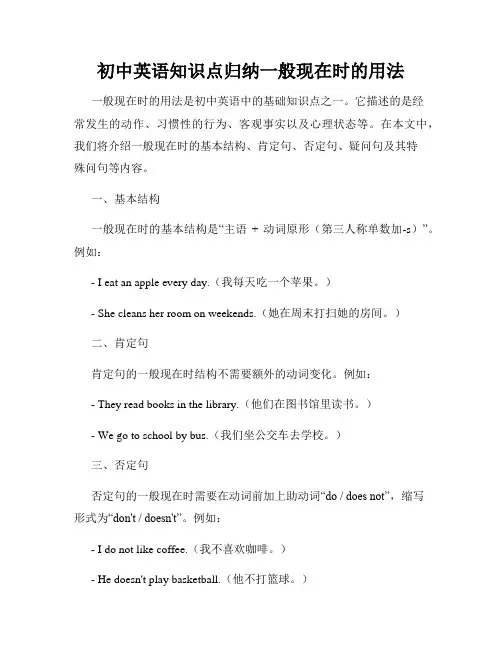
初中英语知识点归纳一般现在时的用法一般现在时的用法是初中英语中的基础知识点之一。
它描述的是经常发生的动作、习惯性的行为、客观事实以及心理状态等。
在本文中,我们将介绍一般现在时的基本结构、肯定句、否定句、疑问句及其特殊问句等内容。
一、基本结构一般现在时的基本结构是“主语+ 动词原形(第三人称单数加-s)”。
例如:- I eat an apple every day.(我每天吃一个苹果。
)- She cleans her room on weekends.(她在周末打扫她的房间。
)二、肯定句肯定句的一般现在时结构不需要额外的动词变化。
例如:- They read books in the library.(他们在图书馆里读书。
)- We go to school by bus.(我们坐公交车去学校。
)三、否定句否定句的一般现在时需要在动词前加上助动词“do / does not”,缩写形式为“don't / doesn't”。
例如:- I do not like coffee.(我不喜欢咖啡。
)- He doesn't play basketball.(他不打篮球。
)四、疑问句疑问句的一般现在时需要将助动词“do / does”置于句首,并将主语与动词的位置互换。
例如:- Do you have a pen?(你有一支钢笔吗?)- Does she watch TV every evening?(她每天晚上看电视吗?)五、特殊疑问句特殊疑问句的一般现在时需要以特殊疑问词(如what, where, when, why, how等)开头,并按照疑问句的结构进行构建。
例如:- What do you do in your free time?(你在空闲时间都做些什么?)- How often does he go swimming?(他多久去游泳一次?)六、陈述句、否定句和疑问句的转换为了让学生更好地理解一般现在时的用法,可以通过转换不同的句子形式来练习。

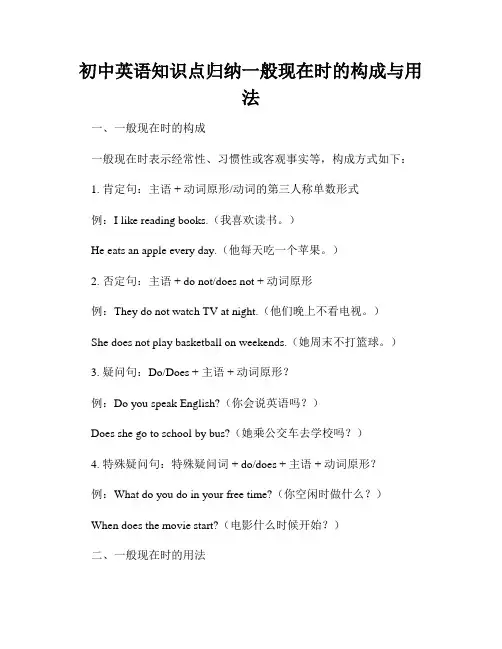
初中英语知识点归纳一般现在时的构成与用法一、一般现在时的构成一般现在时表示经常性、习惯性或客观事实等,构成方式如下:1. 肯定句:主语 + 动词原形/动词的第三人称单数形式例:I like reading books.(我喜欢读书。
)He eats an apple every day.(他每天吃一个苹果。
)2. 否定句:主语 + do not/does not + 动词原形例:They do not watch TV at night.(他们晚上不看电视。
)She does not play basketball on weekends.(她周末不打篮球。
)3. 疑问句:Do/Does + 主语 + 动词原形?例:Do you speak English?(你会说英语吗?)Does she go to school by bus?(她乘公交车去学校吗?)4. 特殊疑问句:特殊疑问词 + do/does + 主语 + 动词原形?例:What do you do in your free time?(你空闲时做什么?)When does the movie start?(电影什么时候开始?)二、一般现在时的用法一般现在时用于以下几种情况:1. 表示经常性或习惯性的动作或状态。
例:My mother often cooks dinner for us.(我妈妈经常给我们做晚饭。
)We usually go to the park on weekends.(我们通常在周末去公园。
)2. 表示客观事实、自然规律或科学真理。
例:The sun rises in the east.(太阳从东方升起。
)Water boils at 100 degrees Celsius.(水在100摄氏度沸腾。
)3. 表示现有状况或个人特征。
例:I have two cats.(我有两只猫。
)She lives in London.(她住在伦敦。
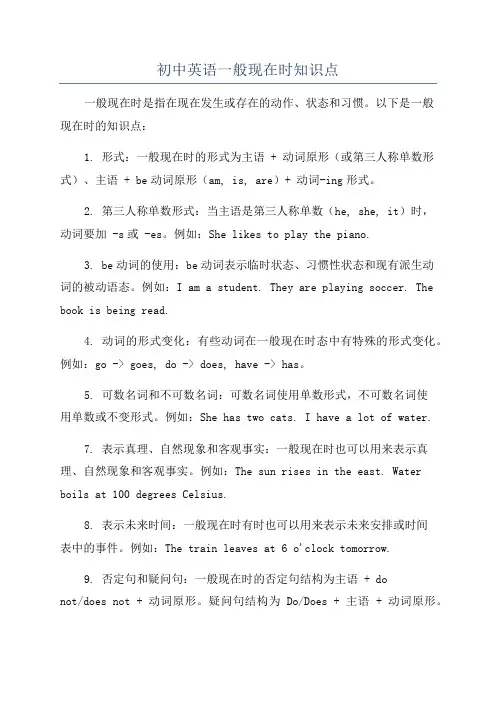
初中英语一般现在时知识点一般现在时是指在现在发生或存在的动作、状态和习惯。
以下是一般现在时的知识点:1. 形式:一般现在时的形式为主语 + 动词原形(或第三人称单数形式)、主语 + be动词原形(am, is, are)+ 动词-ing形式。
2. 第三人称单数形式:当主语是第三人称单数(he, she, it)时,动词要加 -s或 -es。
例如:She likes to play the piano.3. be动词的使用:be动词表示临时状态、习惯性状态和现有派生动词的被动语态。
例如:I am a student. They are playing soccer. The book is being read.4. 动词的形式变化:有些动词在一般现在时态中有特殊的形式变化。
例如:go -> goes, do -> does, have -> has。
5. 可数名词和不可数名词:可数名词使用单数形式,不可数名词使用单数或不变形式。
例如:She has two cats. I have a lot of water.7. 表示真理、自然现象和客观事实:一般现在时也可以用来表示真理、自然现象和客观事实。
例如:The sun rises in the east. Water boils at 100 degrees Celsius.8. 表示未来时间:一般现在时有时也可以用来表示未来安排或时间表中的事件。
例如:The train leaves at 6 o'clock tomorrow.9. 否定句和疑问句:一般现在时的否定句结构为主语 + donot/does not + 动词原形。
疑问句结构为Do/Does + 主语 + 动词原形。
以上是一般现在时的主要知识点,通过学习和掌握这些知识点,你就能正确运用一般现在时来描述现在的动作、状态和习惯。
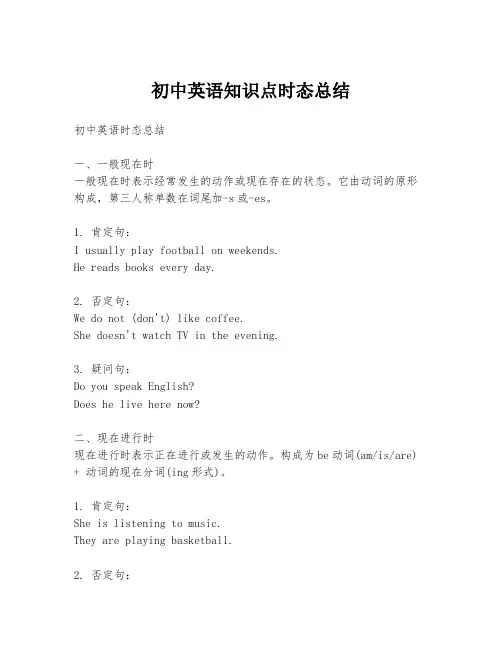
初中英语知识点时态总结初中英语时态总结一、一般现在时一般现在时表示经常发生的动作或现在存在的状态。
它由动词的原形构成,第三人称单数在词尾加-s或-es。
1. 肯定句:I usually play football on weekends.He reads books every day.2. 否定句:We do not (don't) like coffee.She doesn't watch TV in the evening.3. 疑问句:Do you speak English?Does he live here now?二、现在进行时现在进行时表示正在进行或发生的动作。
构成为be动词(am/is/are) + 动词的现在分词(ing形式)。
1. 肯定句:She is listening to music.They are playing basketball.2. 否定句:I am not (aren't) studying right now.The children are not (aren't) doing their homework.3. 疑问句:Is she cooking dinner?Are you waiting for someone?三、一般过去时一般过去时表示过去某个时间发生的动作或存在的状态。
规则动词在词尾加-ed,不规则动词则有特殊形式。
1. 肯定句:He walked to school yesterday.I visited my grandparents last week.2. 否定句:We did not (didn't) go to the cinema.She didn't buy anything at the store.3. 疑问句:Did you travel abroad last year?Did he finish his homework?四、过去进行时过去进行时表示过去某个时间点正在进行的动作。
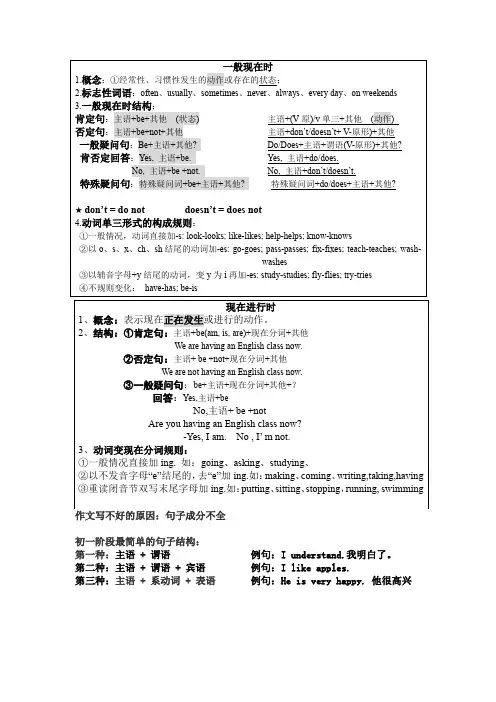
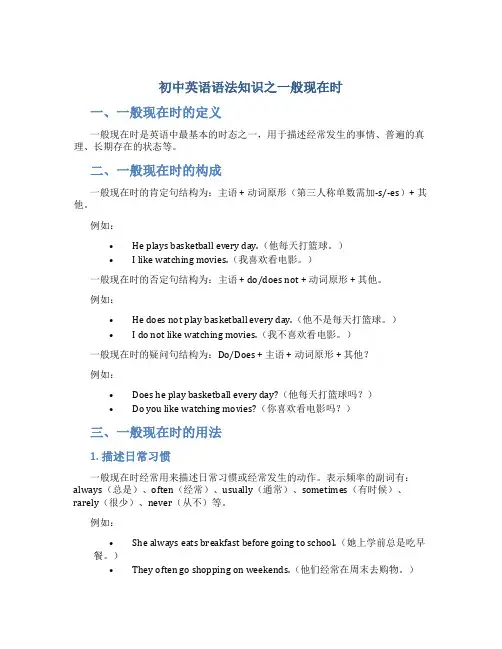
初中英语语法知识之一般现在时一、一般现在时的定义一般现在时是英语中最基本的时态之一,用于描述经常发生的事情、普遍的真理、长期存在的状态等。
二、一般现在时的构成一般现在时的肯定句结构为:主语 + 动词原形(第三人称单数需加-s/-es)+ 其他。
例如:•He plays basketball every day.(他每天打篮球。
)•I like watching movies.(我喜欢看电影。
)一般现在时的否定句结构为:主语 + do/does not + 动词原形 + 其他。
例如:•He does not play basketball every day.(他不是每天打篮球。
)•I do not like watching movies.(我不喜欢看电影。
)一般现在时的疑问句结构为:Do/Does + 主语 + 动词原形 + 其他?例如:•Does he play basketball every day?(他每天打篮球吗?)•Do you like watching movies?(你喜欢看电影吗?)三、一般现在时的用法1. 描述日常习惯一般现在时经常用来描述日常习惯或经常发生的动作。
表示频率的副词有:always(总是)、often(经常)、usually(通常)、sometimes(有时候)、rarely(很少)、never(从不)等。
例如:•She always eats breakfast before going to school.(她上学前总是吃早餐。
)•They often go shopping on weekends.(他们经常在周末去购物。
)2. 表达客观事实或普遍真理一般现在时也被用来表达客观事实或普遍真理。
例如:•The Earth revolves around the sun.(地球绕太阳运行。
)•Water boils at 100 degrees Celsius.(水在100摄氏度沸腾。
初中英语语法总结一般现在时一般现在时是英语中最常用的时态之一,用来表达经常或习惯性发生的动作、现实存在的情况、普遍真理等。
以下是初中英语语法总结一般现在时的重点内容:1.基本用法:- 表示经常性或习惯性动作:I usually go to school by bus.(我通常乘公交车去上学。
)- 表示现实存在的情况:She lives in London.(她住在伦敦。
)- 表示普遍真理:Water boils at 100 degrees Celsius.(水在100摄氏度烧开。
)2.句子结构:- 肯定句:主语 + 动词原形 + 其他。
I like to play basketball.(我喜欢打篮球。
)- 否定句:主语 + do not / does not + 动词原形 + 其他。
He does not like to eat vegetables.(他不喜欢吃蔬菜。
)- 疑问句:Do / Does + 主语 + 动词原形 + 其他?Do you play soccer?(你踢足球吗?)3.第三人称单数:- 在第三人称单数主语(he,she,it)中,动词要加-s或-es,否定句和疑问句中需用 does。
He watches TV every evening.(他每晚看电视。
)- 一些以s, sh, ch, x, o结尾的单词,需要在动词后加-es,如:misses,washes,watches。
4.频率副词:- 频率副词通常放在动词之前,用于修饰动词。
例如:She always helps others.(她总是帮助别人。
)5.现在进行时与一般现在时的区别:- 现在进行时表示现在正在发生的动作,一般与现在时间状语连用,或表示现阶段的临时情况。
例如:I am studying for the exam.(我正在准备考试。
- 一般现在时表示经常性、习惯性的动作或客观存在的状态。
例如:I usually play soccer on weekends.(我通常在周末踢足球。
一般现在时知识点详解(初中英语专题复习)知识点01 一般现在时的构成【语法详解】一般现在时表示经常性的动作或存在的状态,多与时间状语always,often,sometimes,every day,in the morning等连用。
once a week,twice a month等表示频率的词组也常用于一般现在时。
在一般情况下用动词原形,若主语为第三人称单数,一般在动词原形后加-s或-es。
【答案】teaches【详解】句意:王老师在周日教我们英语。
时间状语“on Sundays”是一般现在时标志词,主语“Mr. Wang”是第三人称,动词用三单形式,故填teaches。
知识点02 一般现在时的用法【语法详解】①表示经常性、习惯性的动作或存在的状态。
常与频度副词连用。
I often take a walk in the park. 我经常在公园散步。
These T-shirts are new. 这些T恤衫是新的。
①表示客观事实、真理。
The sun rises in the east and sets in the west. 太阳东升西落。
①在时间、条件状语从句中表示将来的动作。
If it doesn’t rain tomorrow, I will go bike riding in the open air. 如果明天不下雨,我将在户外骑自行车。
I’ll tell her the good news when she comes back. 当她回来的时候,我将把这个好消息告诉她。
①表示按计划或安排将要发生的动作,可用一般现在时表将来。
但只限于start,begin,leave,go,come,arrive,return,take place等。
【即学即练】She’s brought you some eggs. As you know, she ______chickens.A. keepsB. will keepC. has keptD. kept【答案】A【详解】句意:她给你带了些鸡蛋。
初中英语知识点总结一般现在时一般现在时是指发生在现在的动作或状态。
在句子中,一般现在时的动词使用原形形式。
这里是一些与一般现在时相关的重要知识点。
1.一般现在时的肯定句结构:主语+动词原形+其他例如:- I go to school every day.- She reads a book in the evening.2. 一般现在时的否定句结构:主语 + do/does not + 动词原形 +其他例如:- I do not go to school on Sundays.- She does not like to eat vegetables.3. 一般现在时的疑问句结构:Do/Does + 主语 + 动词原形 + 其他?例如:- Do you like to play basketball?- Does he go to the movies on weekends?例如:- I always go to bed early.- He never eats breakfast.5. 表示客观真理、规律或常识时,一般现在时可用于所有人称,不需要使用助动词do/does。
例如:- The sun rises in the east.- Water boils at 100 degrees Celsius.6. 当主语为第三人称单数时,动词需要变化。
一般情况下,加上-s 或-es。
例如:- She eats lunch at 12 o'clock.- The dog barks loudly.7.部分动词在第三人称单数时需要做变化- go→goes- do→does- have→has例如:- He goes to school by bus.- She does her homework every day.- My mother has a pet cat.8. 当主语为we, they, you或复数名词时,动词不需要做变化。
初中英语语法知识之一般现在时有很多同学分不清时态,时态是一篇文章的主线,如果时态都分不清那我们就分不清事情发生的先后,会对我们做题设障碍,所以今天小编为大家整理了一些时态上的知识,希望能帮到大家。
一般现在时表示现在经常反复发生的动作、存在的状态或习惯性的动作的时态。
一、一般现在时用法如下:1.表示现在的状态: e.g. He’s twelve. She’s at work.2.表经常或习惯性的动作,常与表示频度的时间状语连用。
: eg. I get up at 6:30 every day.He reads English every morning.3.表主语具备的性格、能力和特征。
e.g. I don't like this book.4.表示客观事实和普遍真理。
The earth moves around the sun.5. 在时间状语从句和条件状语从句中,常用一般现在时代替将来时。
eg. I'll write to you as soon as I arrive there.二、一般现在时构成:一般现在时用行为动词的原形,但第三人称单数作主语时,动词要用第三人称单数形式。
第三人称单数形式的变化规则是:1.一般的动词词尾+S。
2.以sh/ch/s/x 结尾的词+es.3.以辅音字母+Y 结尾的把 Y 变成 i,+es。
4.辅音字母+o 结尾的+es.基本结构:1.be 动词肯定句:主语+be(am,is,are)+其它。
如: I am a boy.我是一个男孩。
否定句:主语+ be + not +其它。
如:He is not a worker.他不是工人。
一般疑问句:Be +主语+其它。
如:-Are you a student? -Yes. I am. / No, I'm not.特殊疑问句:疑问词+一般疑问句。
如:Where is my bike?2.行为动词1) 当主语为第一,二人称及复数时,助动词为 do肯定句:主语+动词原形(+其它)。
中考英语必会时态1.一般现在时(do/does; is/am/are)①表示现在的情况、状态或特征。
例:He is a student.他是一个学生。
②表示经常性、习惯性动作。
例:He always helps others.他总是帮助别人。
③客观事实和普遍真理。
例:The earth moves the sun.地球绕着太阳转。
④表示一个按规定、计划或安排要发生的动作。
仅限于某些表示“来、去、动、停、开始、结束、继续”等的动词,可以与表示未来时间的状语搭配使用。
常见的用法是:飞机、火车、轮船、汽车等定期定点运行的交通方式。
例:The next train leaves at 3 o'clock this afternoon.下一趟火车今天下午3点开车。
⑤在时间、条件和让步状语从句中经常用一般现在(有时也用现在完成时)表示将的来事情。
(即:主将从现原则)例:I will call you as soon as I arrive at the airport.我一到机场就会给你打电话。
2.现在进行时(am/is/are doing)①表示此时此刻正在发生的事情。
例:He is listning to the music now.他现在正在听音乐。
②表示目前一段时间内一直在做的事情,但不一定此时此刻正在做。
例:I am studying computer this term.这个学期我一直在学习计算机。
③现在进行时可以表示将来的含义。
瞬时动词的进行一定表将来。
例:I am leaving.我要离开了。
持续动词的进行只有有将来的时间状语或有将来语境中才表将来。
例:I am travelling next month.下个月我要去旅行。
④现在进行时与频度副词连用,表示说话者或褒义或贬义的感情色彩。
例:He is always helping others.他总是帮助别人。
(褒义)3.现在完成时(have/has done)①表示动作到现在为止已经完成或刚刚完成,强调对现在产生的影响。
初中英语一般现在时的知识点归纳以下是简略的初中英语一般现在时的常见知识点归纳:一、一般现在时说明的是发生在现在的情况或事实,常用的句式有:1、第三人称单数加es。
比如:He speaks English.2、以s结尾的动词。
如:She goes to school every day.3、动词to be。
例如:We are students.4、动词to do作实义动词时(也就是说做“办事”),习惯上用do而非does。
比如:I do my homework every day.5、其他动词加-s,-es,或-ies。
例如:She reads a book every day.二、一般现在时的肯定句的一般结构为:主语+动词的一般现在式。
例如:He speaks English every day.三、一般现在时的疑问句的一般结构为:Do/Does+主语+动词原形。
例如:Do you speak English?四、一般现在时的祈使句没有谓语动词,而是以动词原形开头,来表示请求、劝告、命令或者建议。
例如:Let’s go.五、一般现在时使用一般现在时也可以表示经常性或者习惯性的动作发生。
例如:She usually takes a bus to school.综上所述,初中英语一般现在时是指发生在现在的情况或事实,一般句的肯定句的一般结构为:主语+动词的一般现在式,而疑问句为Do/Does+主语+动词原形,祈使句以动词原形开头,来表示请求、劝告、命令或者建议,一般现在时也可以表示经常性或者习惯性的动作发生。
英语学习者一定要熟练掌握这些基本的知识,以便更自信地应用这一时态。
初中英语一般现在时知识点
其动词形式是:动词原形(只有第三人称单数作主语时除外,要加-s)其疑问句和否定句需要用助动词do或does
1) 肯定句用行为动词原形表示
They get up very early every morning. 他们每天早晨起
来很早。
I visit my grandparents four times a month. 我一个月
去看望祖父母四次。
2) 否定句用don’t + 动词原形来表示
We do not go shopping on Sundays. 我们周日不去购物。
I don’t think you like this colour. 我想你不喜欢这
个颜色。
3) 一般疑问句则是把助动词do提前至句首,后面动词用原形。
回答时,肯定用“Yes, 主语+do”;否定句用“No, 主语
+don’t”。
–Do they go to school at seven o’clock? 他们七点去
上学吗?
--Yes, they do.
--Do you like this skirt? 你喜欢这条裙子吗?
--No, I don’t. 不,我不喜欢。
一般现在时用来表示经常的或习惯性的动作,常与以下的时
间状语连用:often 经常,always 总是,sometimes 有时,usually 通常,every day/ week 每天/ 周等。
He usually goes to school by bike. 通常他骑车上学。
I visit my grandparents every week. 我每个星期都去看
祖父母。
She is always late for class. 她总是上课迟到。
My parents and I sometimes go out to eat. 我和父母有
时出去吃饭。
It often rains here. 这儿常常下雨。
主语为第三人称单数时的一般现在时
一般现在时态,当主语为第三人称单数时,谓语动词也要是
第三人称单数,后要加-s或-es。
He likes reading at night. 他喜欢夜里读书。
She usually goes to school by bike. 她平时骑车上学。
The little cat drinks milk every day. 小猫每天都喝牛奶。
转换成否定句要加doesn’t,其后的动词用原形。
Kelly doesn’t get up early on Saturdays and Sundays. 凯丽星期六星期天起床不早。
He doesn’t feel well today. 他今天感觉不舒服。
转换成一般疑问句,句首用Does,其后的动词用原形。